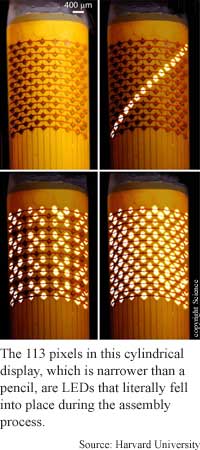
Shake
and serve
By
Eric Smalley,
Technology Research NewsShaking is a good way to break things, especially electronic devices that contain many components. A team of researchers at Harvard University has found that shaking can also have the reverse effect.
The researchers have developed an assembly process that boils down to making a cocktail -- shaken, not stirred -- of electronic components and copper wires in a vial of hot water. The technique is one of a growing number of self-assembly processes that could dramatically lower manufacturing costs for electronic devices ranging from sensors to computers.
The Harvard team demonstrated their patterned self-assembly process by making a cylindrical display about 4 millimeters in diameter that contained 113 light-emitting diodes (LEDs). The shape of the display proves the process is not restricted to flat surfaces, which is a limitation of current manufacturing techniques, said Heiko O. Jacobs, a member of the team who is now an assistant professor of electrical and computer engineering at the University of Minnesota.
The researchers began with an array of 113 copper squares that were connected via copper wires and mounted on a plastic sheet. The squares, which measured 280 microns each, were coated with a solder that melts at relatively low temperatures. The first steps in the process were rolling the sheet into a cylinder, putting it in a vial of water, adding 113 280-micron-square LEDs, and heating the water above the melting temperature of the solder.
The researchers found that they could get the LEDs to adhere to the copper squares by gently shaking the vial by hand for one to two minutes. Tapping the vial with a metal rod shook loose LEDs that adhered to wires between squares or that stuck two to a square, and shaking the vial some more got these last LEDs to stick to the right places.
The gold contacts on the bottoms of the LEDs stuck to the liquid solder because of the same force that causes adjacent drops of liquid to merge. Molecules on the surface of a liquid have higher energy, and are therefore less stable, than molecules within the liquid, said Jacobs. Drops of liquid merge because liquids naturally reduce surface area to become stable, he said. "In our system, the solder bumps capture light emitting diodes for the same reason," said Jacobs.
They finished the display by hand positioning another plastic sheet with copper squares on top of the LEDs.
The advantages of the researchers' patterned self-assembly process are that it does not require expensive machinery, it works on curved and flexible surfaces, and it handles small components, said Jacobs. Because the process handles smaller components it could be used to make higher-resolution displays than are possible with conventional approaches, he added.
A display like the researchers' small cylinder prototype could be used for a future combination pen and cell phone or similar device, said Jacobs.
Making more complicated devices that have different types of components is likely to require shape-selective recognition and hierarchical self-assembly techniques in addition to the researchers' cocktail-mixing approach, according to Jacobs. Shape-selective recognition is a process for building components with shapes that combine in only one way, said Jacobs. "Hierarchical self-assembly is self-assembly of tiny things into small aggregates, and then further self-assembly of the small aggregates into larger aggregates, and so on," he said.
The researchers' patterned self-assembly process could be put to practical use in five to ten years, said Jacobs.
Jacobs' research colleagues were Andrea R. Tao, Alexander Schwartz, David H. Gracias and George M. Whitesides of Harvard University. They published the research in the April 12, 2002 issue of the journal Science. The research was funded by the National Science Foundation (NSF), the Defense Advanced Research Projects Agency (DARPA), the German Science Foundation and the Swiss National Science Foundation.
Timeline: 5-10 years
Funding: Government
TRN Categories: Materials Science and Engineering
Story Type: News
Related Elements: Technical paper, "Fabrication of a Cylindrical Display by Patterned Assembly," Science, April 12, 2002
Advertisements:
April 17/24, 2002
Page One
Shake and serve
Odds not hopeless for new Web sites
Content scheme banishes browser plug-ins
Polarized light speeds messages
File compressor ID's authors

News:
Research News Roundup
Research Watch blog
Features:
View from the High Ground Q&A
How It Works
RSS Feeds:
News
Ad links:
Buy an ad link
| Advertisements:
|
 |
Ad links: Clear History
Buy an ad link
|
TRN
Newswire and Headline Feeds for Web sites
|
© Copyright Technology Research News, LLC 2000-2006. All rights reserved.